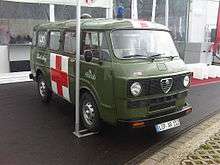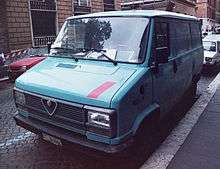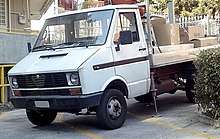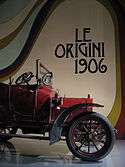Alfa Romeo Romeo
The Alfa Romeo Romeo was a light commercial, cabover van and pickup truck that was introduced by the Italian automaker Alfa Romeo in 1954 as the Alfa Romeo Autotutto ("all purpose"). The line of vans continued to be built until 1983, when it was replaced by relabelled Fiat and Iveco commercials.
| Alfa Romeo Romeo | |
|---|---|
 Alfa Romeo Romeo 2 Furgone | |
| Overview | |
| Manufacturer | Alfa Romeo |
| Production | 1954-1983 |
| Assembly | Italy Spain (Romeo 2) |
| Body and chassis | |
| Class | Light commercial vehicle (M) |
| Body style | Van Pickup truck |
| Layout | FF layout |
Romeo
| Alfa Romeo Romeo | |
|---|---|
| Overview | |
| Manufacturer | Alfa Romeo |
| Also called | Alfa Romeo T10 Alfa Romeo Autotutto |
| Production | 1954-1956[1] |
| Powertrain | |
| Engine | 1,290 cc petrol I4 1,158 cc I2 supercharged diesel |
The first Alfa Romeo T10 "Autotutto" ("all purpose") was presented in 1954 Turin Motor Show as panel and minibus version. Later more versions came available as Alfa Romeo made themselves with very many body versions: van, high roof van, "Promiscuo" (van with additional side windows and rear seating), minibus, school bus, ambulance, pick-up, drop-side truck and double cab truck. In addition to this many coachbuilding companies made their own versions. The van used the 1,290 cc Alfa Romeo Twin Cam straight-four engine detuned to 35 bhp (26 kW) and it had top speed of 60 mph (97 km/h).[2] This engine was later used on Giulietta Berlina. The optional two-cylinder supercharged diesel engine had 30 bhp (22 kW).
Romeo 2
| Alfa Romeo Romeo 2 | |
|---|---|
 Romeo 2 lorry | |
| Overview | |
| Production | 1954-1967[1] |
| Powertrain | |
| Engine | 1,290 cc petrol I4 1,158 cc 2-cyl supercharged diesel |
| Transmission | 4-speed manual ZF transmission |

The updated Romeo 2 version was introduced in 1954, it was assembled in Italy and also built under license in Spain by FADISA (Fabricacion de Automoviles Diesel S.A.), this Spanish version had a 1.6 liter Perkins 4/99 diesel engine and a gearbox with synchro on all forward gears.[2]
Romeo 3
| Alfa Romeo Romeo 3 | |
|---|---|
| Overview | |
| Also called | Alfa Romeo Romeo |
| Production | 1966 |
| Powertrain | |
| Transmission | 4-speed manual ZF transmission |
| Chronology | |
| Predecessor | Romeo 2 |
| Successor | A12/F12 |
The final version Romeo 3 was introduced in 1966. The Romeo 3 had some improvements like hydraulic clutch and adjustable driver's seat. The Romeo 3 had a production run of only some 6 months or so before being replaced by the Giulia 1300 engined F12 and A12 models. In all, some 23,000 Romeos had been produced between 1954 and 1966.[3]
F12/A12 and F11/A11
| Alfa Romeo F11/F12/A11/A12 | |
|---|---|
| Overview | |
| Production | 1967-1983 1973-1983 (diesel)[1] 17,899 |
| Powertrain | |
| Engine | 1,290 cc straight-4 petrol 1,760 cc Perkins 4.108 diesel |
| Transmission | 4-speed manual ZF transmission |
| Dimensions | |
| Wheelbase | 230 cm (91 in)[1] |
| Length | 449 cm (177 in)[1] |
| Width | 180 cm (71 in)[1] |

The Autotutto was replaced with Giulia engined Alfa Romeo F12 and A12 vans in 1967.[4]
The front of the car was updated with wider chrome and mesh grill, also the 1,290 cc Alfa Romeo Twin Cam engine was updated now having a 52 hp (39 kW). The front-engined van had four-speed gearbox and front-wheel drive. In 1973 an inline-four 1,760 cc Perkins diesel (4.108) was also offered, it had 50 hp (37 kW).[1] This same engine was also available to Giulia sedan from 1976. The van had top speed of around 115 km/h (71 mph). The front brakes were discs and rear ones drums. Abandoning the use of a model name, "F" depicted a furgone, or van, "A" depicted an autocarro or light truck, while "12" indicated the carrying capacity of 12 quintali (1 quintale = 100 kg (220 lb)).[3]
Motor Ibérica took over of FADISA in 1967, this company made Ebro trucks and these FADISA trucks were merged to this same division. As a result, the Alfa Romeo F12 was named as Ebro F-100 in Spain and after the facelift it was sold as the F-108. In 1987 Nissan Motors took control of Motor Ibérica and Ebro trucks were renamed "Nissan Trade". They continued to be made until the beginning of the 2000s at the Ávila plant in Spain.
Between 1967 and 1971 a "light" A11 or F11 version was also available. This has a lighter payload and a lower horsepower rating. All Alfa Romeo vans were facelifted in 1977 with a new black plastic radiator grill, and chrome badging was replaced with black adhesive stickers. Production stopped in 1983. The total production of all A11, A12, F11, and F12 was around 17,300 units.
AR6 and AR8


Some Fiat and Iveco models were also marketed as Alfa Romeos. The AR8 was based on the first generation Iveco Daily, and the AR6 was a rebadged first generation Fiat Ducato. They both received Alfa Romeo's traditional shield-shaped grille.
| External image | |
|---|---|
References
- "ALFA ROMEO T10, A11/F11 og A12/F12". alfaklub.dk (in Danish). Retrieved 2009-08-13.
- "A Romeo? What's That?". alfastop.co.uk. Giulietta Register. Retrieved 2009-08-12.
- "A Romeo? What's That?". romeoregister.com. Retrieved 2012-11-13.
- "Alfa Romeo Romeo 2 Furgone". blackandwhitegarage.com. Archived from the original on 2013-04-10. Retrieved 2009-08-13.
